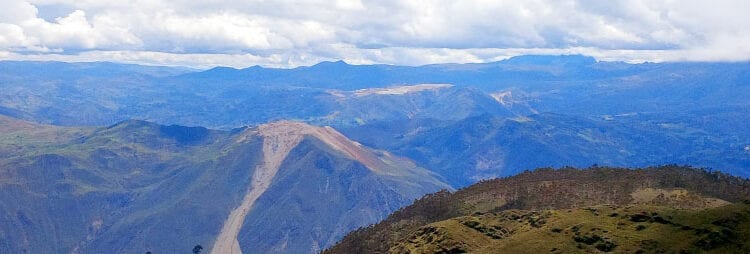Drilling Success At Iska Iska Project In Bolivia
Eloro Resources Ltd. (TSXV: ELO) has continued its run of drilling success at its Iska Iska silver-tin polymetallic project in Potosi Department, southern Bolivia.
To date, the company has completed 43 diamond drill holes totalling 20,030m to test major target areas at Iska Iska. The latest four additional holes tested the Santa Barbara Breccia Pipe (SBBP) and Central Breccia Pipe (CBP).
To date, every drill hole that has been assayed has returned multiple reportable mineralised intercepts. Currently three drill rigs are in operation at Iska Iska.
One surface drill rig is completing first pass drilling of the CBP from the northern radial platform and a second surface drill is testing the major Porco (South) Target.
The third drill, an underground rig, is testing the northeast part of SBBP and its mineralised envelope.
Highlights:
Hole DSB-08, testing the northeast quadrant of the SBBP, encountered eighteen reportable mineralised intercepts beginning near surface to its terminus at 614.4 m. The longest intercept was 69.89 g Ag eq/t over 252.89m from 355.12 to 608.02m including several higher-grade sections of 196.60 g Ag eq/t including 131.13 g Ag/t over 14.52m, 134.62 g Ag eq/t including 93.25 g Ag/t over 21.08m and 145.35 g Ag eq/t including 2.38% Zn over 10.11m.
Hole DSB-10, testing the southwest quadrant of the SBBP and northern part of the CBP, encountered 29 reportable mineralized intercepts beginning near surface to its terminus at 1,019.4m. Tin was notably elevated in many intervals suggesting proximity to a mineralizing intrusive source in this area. Notable intercepts include 114.96 Ag eq/t including 0.325% tin (Sn) over 56.2m from 322.18m to 378.30m including a higher- grade section of 187.98 g Ag eq/t including 0.535% Sn over 28.86m, 80.71 g Ag eq/t including 0.213% Sn over 74.39m from 474.86 to 549.25m and 118.69 g Ag eq/t over 10.77m from 829.97 to 840.74m.
“We are continuing with our strategy of completing first pass drilling from both surface and underground to test major target areas of the SBBP, CBP and Porco (South),” Dr Bill Pearson, Eloro’s Executive Vice President Exploration, said.
“Targets drilled to date cover an area 2km long by 1.2km wide with additional targets further east in the caldera complex still to be tested.
“All holes drilled to date have intersected significant mineralization and it is becoming clearly evident that the Iska Iska mineralising system is zoned both laterally and vertically.
“Mineralisation at SBBP is more intermediate style polymetallic Ag-Zn-Pb-Sn, whereas recent results from the CBP suggest a deeper level higher temperature tin-dominant system.
“We are currently carrying out a down-hole induced polarization (IP) survey which will aid in determining the distribution of mineralisation especially potential higher-grade areas which tend to have more sulphides.
“Currently we have approximately 2,600 samples in the laboratory pending analysis. ALS Global in Lima, Peru has advised us that they are gradually returning their operations to a more normal basis as the COVID-19 situation improves.
“The backlog of samples has now been stabilized and they anticipate that in the next 4-6 weeks the sample back log will be significantly reduced allowing the laboratory to return to more normal turnaround times. The preparation facility in Oruro continues to operate at normal compacity.“
Dr.Osvaldo Arce, General Manager of Eloro’s Bolivian subsidiary, Minera Tupiza S.R.L., said diamond drilling at Iska Iska to date will allows the definition of a preliminary lateral and vertical metal zoning model in this large km- scale mineralised polymetallic system.
“This zoning is from a higher temperature core characterized by Sn moving outward to Sn (W-Au-Bi), Sn-Ag (Bi), Ag−Zn-Pb-(Sn-Au-Cu), and finally Zn-Pb-Au.
“These zones are arranged according to a decrease of temperature of deposition and increasing distance from the presumed heat source that is likely a Sn porphyry at depth.
“Mineralisation can be telescoped depending on the geochemical environment, the character of metal-forming solutions and the extent of subsequent structural overprinting and remobilisation.
“Remobilisation is likely responsible for producing significant areas of high-grade mineralisation within the more extensive lower grade envelope.”
“Hole DPC-01, the first hole drilled in the Porco target zone, intersected 767 meters of an intercalation of mineralized granodiorite and intrusion breccia with aphanitic dacite and sandstone clasts which confirmed that Porco is likely a major breccia pipe.
“The last 72m of this hole intersected medium to coarse granodiorite which is still mineralized. Mineralisation in this hole is related to breccia veins, veins and veinlets of pyrite, cassiterite, tourmaline, chalcopyrite, sphalerite, galena, pyrrhotite, siderite and alunite collectively up to 7%. Assays on this hole are pending but the potential metal contents appear to be more comparable to the higher level SBBP than the deeper level CBP.
“As previously reported (March 29, 2021), channel sampling of the Porco adit located approximately 200m to the south of the Porco breccia pipe target (Figure 1) returned a 50m strike length averaging 519.35 g Ag eq/t (236.13 g Ag/t, 1.89g Au/t, 0.2% Bi, 0.87% Cu, 0.31% Pb and 0.055% Sn) over an average channel width of 2.5m supporting this conclusion.”
For further information please visit: https://www.elororesources.com/












